The NVIDIA SHIELD Android TV Review: A Premium 4K Set Top Box
by Ganesh T S on May 28, 2015 3:00 PM EST- Posted in
- Media Streamer
- Home Theater
- TV
- 4K
- Shield
- NVIDIA
Graphics Performance
While the SHIELD Android TV and the underlying Tegra X1 SoC are by no means slouches on the CPU side of matters, ultimately NVIDIA is still just another ARM Cortex implementer. On the other hand when it comes to GPUs, this is where NVIDIA truly shines. As NVIDIA is first and foremost a GPU company, and as a design philosophy always invests more time and die space into GPUs than any other SoC builder (save perhaps Apple X-class SoCs), they have always led the pack on GPU performance. And with the Tegra X1 packing a 256 CUDA core implementation of the very potent Maxwell GPU architecture, an estimated 1GHz clockspeed, and all the power and cooling it needs to keep from throttling, all of the ingredients are in place for a very strong showing from NVIDIA for GPU performance.
If there’s any real downside for NVIDIA and the SHIELD Android TV here, it’s that the Android GPU benchmarking situation hasn’t really caught up with what their GPUs are capable of. The standard benchmarks work, but game benchmarks are virtually non-existent, even in the AA and AAA games NVIDIA has helped bring over to the Android/SHIELD ecosystem. So we can’t for example look at the performance of The Talos Principle in the same way as we can the PC today.
Anyhow, we’ll start off with 3DMark’s Ice Storm Unlimited benchmark.
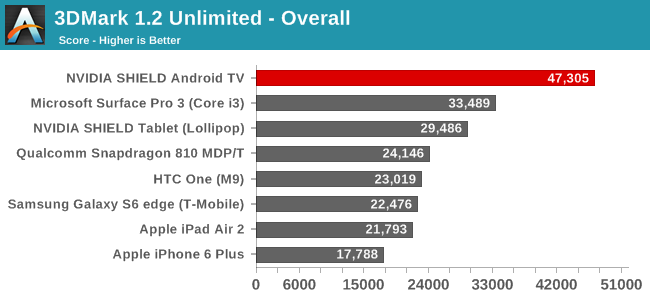
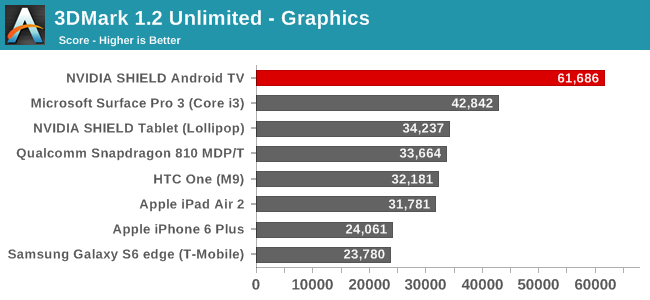
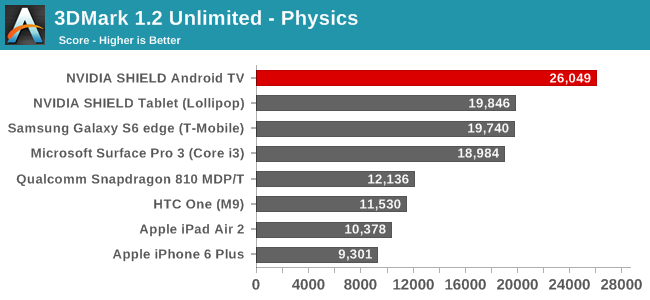
The results here pretty much speak for themselves, especially in the all-GPU graphics sub-score. SHIELD Android TV is 50% faster than the Surface Pro 3 and almost twice as fast as other devices like the iPad Air 2 and the last-generation SHIELD Tablet. Graphics workloads tend to be the most punishing from a heat and power standpoint, and hence are the most likely to get throttled. This really lets the SHIELD and its SoC open up here. At the same time, even in the physics score and the composite overall score, the SHIELD is well in the lead thanks to this combination of factors.
Up next we have BaseMark X 1.1.
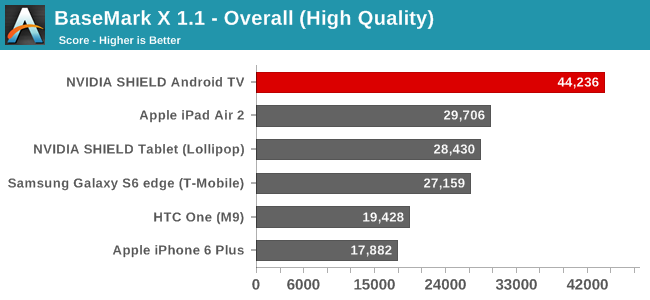
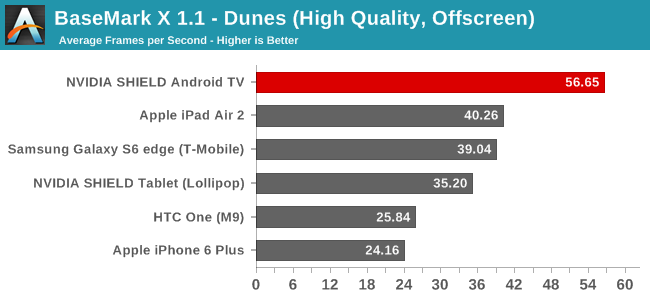

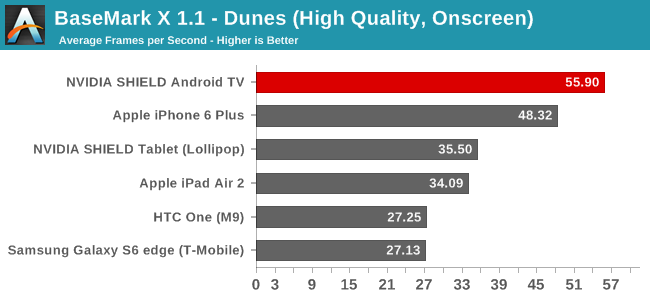
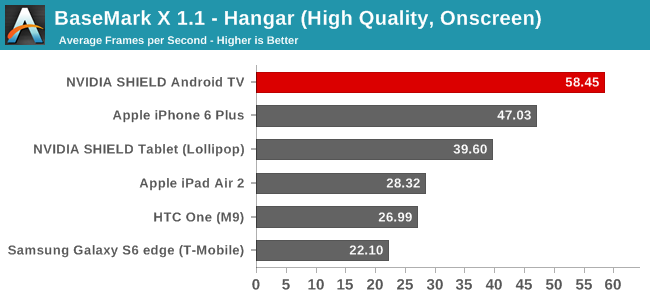
Once more it’s a clean sweep for the SHIELD. Apple’s iPad Air 2 tends to be the second-place finisher, thanks to Apple’s own significant investment in GPU resources, the SHIELD gets yet more resources and the power to fully exploit them. With all of that said, the one thing that does surprise me a bit here is that even the SHIELD can’t crack 60fps on Dunes and Hangar; BaseMark X will likely take one more generation before its tests can be completely beaten.
Our final GPU benchmark is GFXBench.

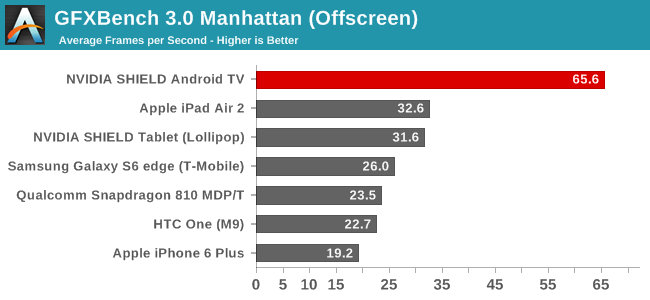
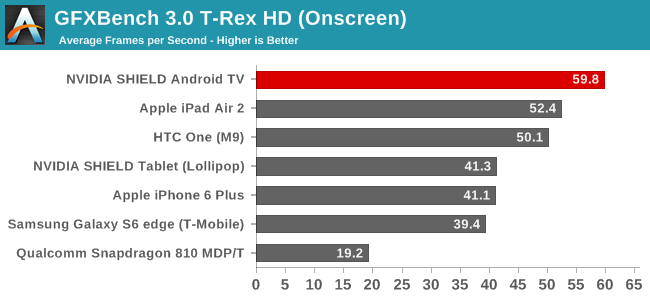
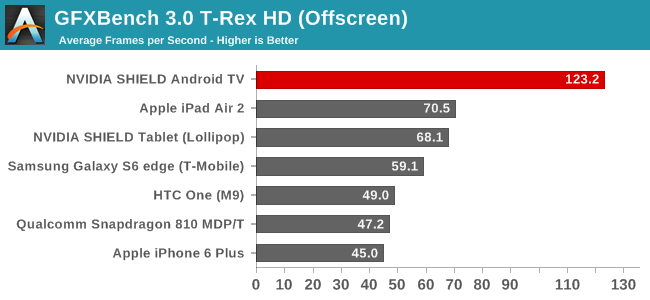
Starting first with the benchmark’s high-level tests, we once again find the SHIELD well in the lead. Of particular note here, the SHIELD Android TV becomes the first Android device to break 60fps on Manhattan, something that as recently as a generation ago seemed impossibly far away.
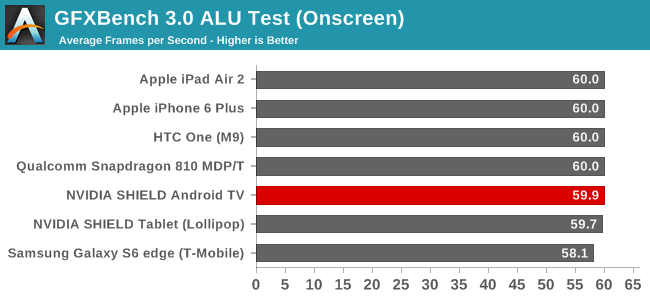
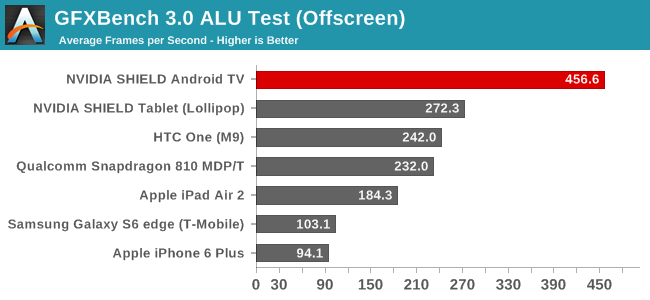

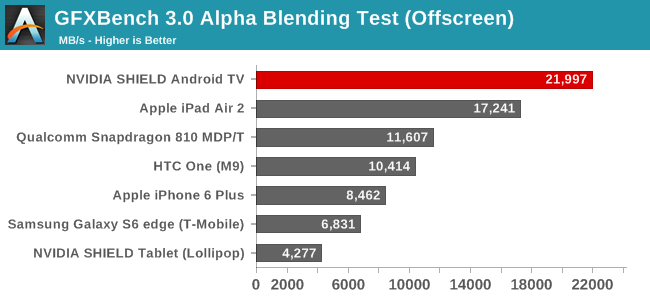
The low-level tests meanwhile offer us an interesting look at SHIELD and Tegra X1 that the high-level tests don’t provide. The ALU test for example drives home the point of just how much in the way of shading resources Tegra X1 has at its disposal (at least when unrestricted), and is a big reason why the SHIELD is doing so well here. On the other hand while NVIDIA still takes the top spot in alpha blending, the lead over the iPad Air 2 isn’t nearly as great, thanks in large part to the iPad’s relatively large 128-bit memory bus. Ultimately SHIELD doesn’t struggle here, but it’s an interesting point of comparison since it shows one of the only cases where SHIELD isn’t a run-away winner, and what kind of graphics workload may eat into its otherwise ridiculous advantage.
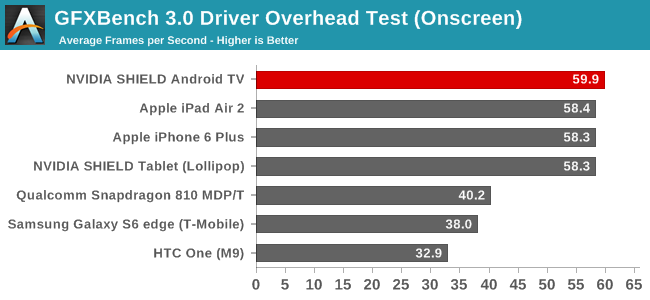
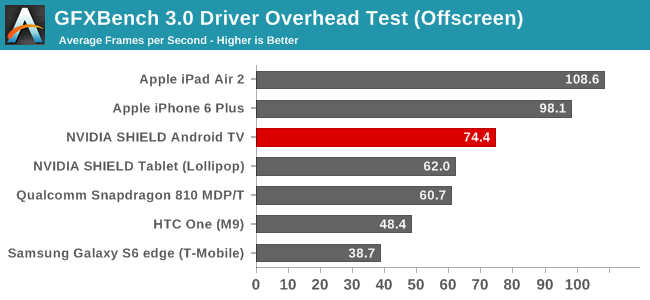
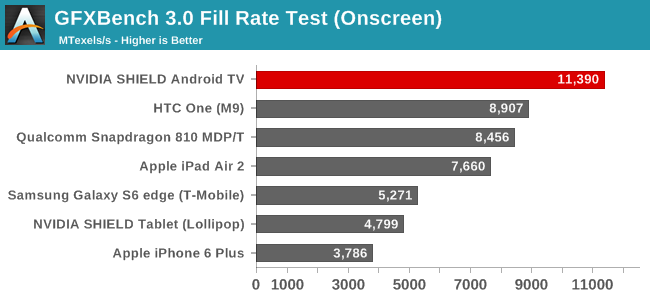
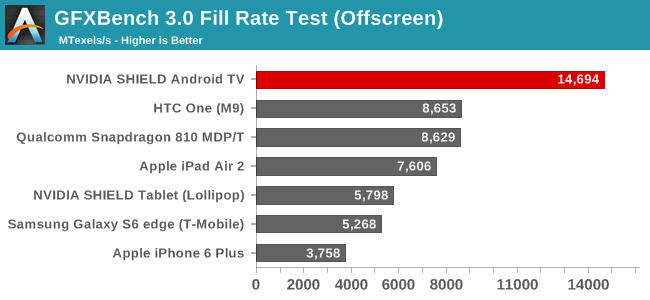
On the last batch of subtests, I’m going to stop again with the fill rate test just to point out another interesting design decision for Tegra X1 and the SHIELD. With NVIDIA banking so much on the set top box’s ability to drive 4Kp60 TVs, NVIDIA needs to push a lot of pixels to get there, as 4K is four-times as many pixels as 1080p. For this reason Tegra X1 is paired with 16 ROPs, giving it low-end PC desktop-like pixel throughput, and of course a huge advantage in the GFXBench fill rate test. And though this fill rate will help with games as well, it’s keeping up with the Android UI at 4Kp60 that is the most important reason for all of this fill rate performance.
Wrapping things up, what else is there to say about the SHIELD Android TV’s GPU performance? What we’re looking at here is twice as fast (or more) than the best phones and tablets today, a combination of the Tegra X1’s very strong GPU design and the set top’s practically unlimited energy and cooling capabilities. Overall NVIDIA is following the path they started long ago on Tegra, always favoring strong GPU performance, leading to the incredible performance we’re seeing here.
With that said, given NVIDIA’s decision to focus on the Android TV aspects of the SHIELD Android TV first and foremost – and not gaming – it’s also fair to say that the SHIELD is overpowered for Android TV work. Other than keeping up with the basic pixel fill needs of 4K, the real power of the box’s GPU is going to be left untapped by Android TV (especially on the ALU side). Which makes all of this humorously absurd in a way, but it’s also why SHIELD Android TV isn’t just an Android TV box. The device’s GPU performance will be put to good use with gaming, though stepping outside the world of benchmarks for a second, the bigger challenge NVIDIA faces is not delivering high performance, it’s delivering games that make full use of that performance.










167 Comments
View All Comments
testbug00 - Friday, May 29, 2015 - link
Nintendo can design a competent OS. The fact their OS runs smoother than Android did for years on Hardware that Android would choke on isn't really a negative.I'm not joking either, the sad part. And, why would the hardware force them to? Why would they risk people being able to pirate all their games super easy?
tipoo - Friday, May 29, 2015 - link
The 3DS, sure, modern android would choke on that hardware. But the design of getting around is still pretty byzantine. Anywho. The Wii U though? With 2GB RAM, half reserved for the OS, and three PowerPC750 based processor cores at 1.2GHz, the thing is still terribly slow for something released so recently. Meanwhile Android is butter with four low power Cortex A7 cores and does ok on 1GB RAM total.Not saying they should or shouldn't. And I'm not sure it would make piracy easier - even going with Android, being open source they can add their old security. Not that the Wii or DS were very secure from piracy either.
tipoo - Friday, May 29, 2015 - link
And what I mean by the 3DS bit...I picked up a 2DS from Target Canada while they were liquidating, half off so I thought what the hell. Didn't have much chance to use it until now.Went into street pass, there was an update available. Ok, go for it. Hit ok, confirm ok, yes it's ok it will take a while. Loads for a minute, then tells me I need to do a system update first. Figure out how to do that, easy enough. Start system update, confirm system update, yes it's fucking ok it will take a while. System update done.
Go back to streetpass plaza, start update. Hit ok, confirm ok, yes it's ok it will take a while. Connecting to online account. Cool. Takes a minute. Then tells me I don't have enough SD storage space. You couldn't check that first?! There's a message that tells me where to go to free storage. So, why can't there just be a button within the message that takes me there?
It could be because every time you close software, there's a button to really close it, and then a confirmation dialogue. Ach, getting real tired of your shit, Nintendo. A few more seconds of wait after you hit the *real* close button, too, because...I dunno. Nintendo.
Delete some crap. Go back to install the thing. Hit ok, confirm ok, yes it's ok it will take a while. Works this time. Go through the new Plaza to see what's new. Go through a bunch of dialogue with a talking rabbit just to see screenshots of each game. You can hold R, but it's still pretty slow.
Did I mention slow? The byzantine software layout may not even bug me as much if the thing was fast, but this is *really* slow. It's old hardware, I get that, plus it was low end hardware even at launch, but that doesn't stop it from being aggravating. The eShop being the worst of it. Going back and forth through pages is painstaking.
Some people have and probably will try to remind me that Nintendo is focused a lot on children. I honestly don't think even kids need all this padding though - this is the iPad generation, they'll get the hang of things in a jiffy, and don't need three confirmations from a talking dildo or whatever weird crap Nintendo wants to do every time they open or close software or after they've already said yes to a download.
Even with more attractive games on it than smartphones have, I find myself almost reluctant to use it every time for the slowness and very pre-iPhone software.
eanazag - Friday, May 29, 2015 - link
Nintendo just needs to give up on the hardware aspect and just distribute software. I would even pay for oldies like Excite Bike on iOS/MS Store/Google Play. I think they can still do regular consoles, but I have been disappointed with them. Good peripherals is still a market they could sell for.If anything, just sell the old stuff on those other services a make a dollar.
mkozakewich - Saturday, May 30, 2015 - link
If I were them, I'd work with a vendor to design a Nintendo Phone. Like, imagine an LG phone with Nintendo branding, a thumbstick, and four buttons? Maybe shoulder buttons, too. Whatever they could fit. (They might be able to get away with shoving all the usual 3DS buttons on.)smorebuds - Tuesday, June 2, 2015 - link
This is more what I was referring too. If Nintendo focused on releasing software (to the Android/iOS market where they'd make the biggest splash) then wouldn't a Nintendo set top box like this Shield make sense too? It would just be the Nintendo-branded and skinned Android box, maybe with some extra Nintendo-specific features thrown in.FMinus - Wednesday, June 3, 2015 - link
Why would they do that, I'm still pretty happy with my WiiU and their hardware offers something that noone else does, or usually copies it in one way or another. Besides Nintendo is sitting on a lot of cash, possibly more as Microsoft and Sony game divisions together anyway, so there's no fear of them going away anytime soon.Aside of that, they are the only company making consoles relatively affordable and kid friendly. Just as an example The Xbox/Playstation UI are an abomination to navigate for a 6 to 10 year old. And most importantly, Nintendo is focusing on games, not being the center of your living room, I'd gladly strip both the Xbox One and Playstation 4 of all the useless features (to me) if they offered them for $250.
stoicromance - Thursday, May 28, 2015 - link
So am I to understand that you can load pretty much any Google Play app onto this? Can I just throw VLC and Plex onto the Shield?Ryan Smith - Thursday, May 28, 2015 - link
Through the Play Store, an app needs to be flagged as supporting the 10ft Android TV UI in order to show up. Though you can sideload practically anything.ganeshts - Thursday, May 28, 2015 - link
Plex already comes pre-bundledVLC doesn't work that well right now on the SHIELD